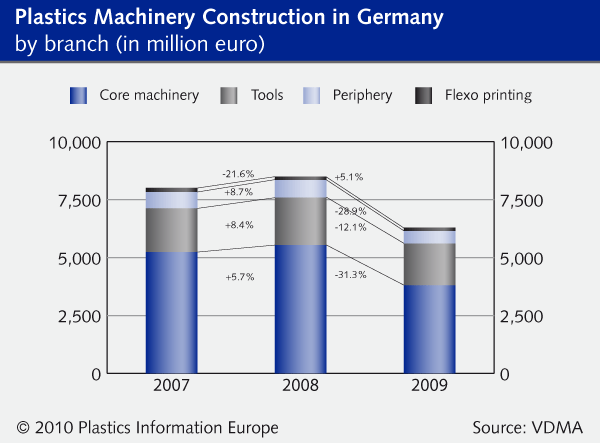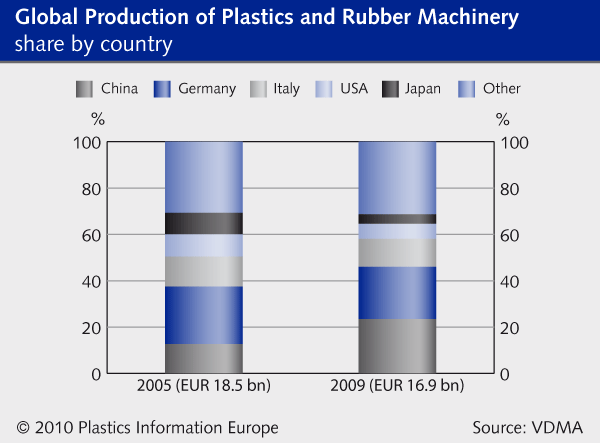GERMAN PLASTICS MACHINERY
Shock is wearing off / Business picking up since October / Exports are driving orders / Domestic market still weak / Injection moulding machines particularly hard hit / China is the new no. 1
The massive crisis that hit the German plastics and rubber machinery sector in 2008 and 2009 was still clearly evident at the annual press conference of KuG, the German plastics and rubber machinery manufacturers association (Frankfurt / Germany; www.kug.vdma.org) on 27 May 2010. Following the massive downslide that started in August 2008, orders started to pick up again in October 2009 and have risen steadily ever since, reported KuG’s chairman Ulrich Reifenhäuser, managing partner of extrusion technology group Reifenhäuser (Troisdorf / Germany; www.reifenhauser.com). Seven months into the upturn, companies are starting to talk about extended delivery deadlines as a result of the downsizing during the recession and some segments are booming in Asia. Nevertheless, uncertainty about the sustainability of the upturn was tangible at the meeting.
KuG estimates that the global value of plastics and rubber machinery produced in 2009 contracted by 23% to EUR 16.9m (2008: EUR 21.9m). The downturn in Germany was slightly more pronounced with output of core machinery, tools, handling peripherals and flexoprinting units dropping 25.9% to EUR 6.3 bn. Despite this, employment was only cut by around 5% to 31,500 employees (33,000), thanks mostly to the flexibility of corporate structures and Germany’s generous short-time working arrangements.
KuG estimates that the global value of plastics and rubber machinery produced in 2009 contracted by 23% to EUR 16.9m (2008: EUR 21.9m). The downturn in Germany was slightly more pronounced with output of core machinery, tools, handling peripherals and flexoprinting units dropping 25.9% to EUR 6.3 bn. Despite this, employment was only cut by around 5% to 31,500 employees (33,000), thanks mostly to the flexibility of corporate structures and Germany’s generous short-time working arrangements.
 | |
Injection moulding sector floored by the automotive crisis
Output of core machinery plunged by 31.3 percent to around EUR 3.8 bn, down from EUR 5.5 bn. Order intake, which had already slipped 22% year-on-year in 2008, fell by a further 28% in 2009. However, export orders offer a glimmer of hope. Having dropped to half the 2005 level at the start of 2009, they had rebounded to well above the levels recorded five years ago by the start of 2010.
The crisis hit the injection moulding machine segment particularly badly. The 52% drop in the value of output from EUR 849m to EUR 406m was probably due to this segment’s high exposure to the automotive sector, where the downturn was the most severe. Since exports increased from an already high 79% to 94% of the total, it seems that virtually no injection moulding machines were sold in Germany, despite its reputation as a mecca of the car industry. For many years injection moulding machines vied with extrusion technology as the sector’s leader. Last year, however, it only accounted for 11% of the country’s total output of rubber and plastics machinery.
Despite rising absolute figures, the relative importance of the segment has been declining for a number of years. Although the trend is not quite as dramatic as in Japan – see Plasteurope.com of 06.04.2010 – it is nevertheless evident that injection moulding machinery is now a source of concern. Germany may be further away from budding China but the collateral damage resulting from the rise of this economic giant is having an impact here, too.
The crisis hit the injection moulding machine segment particularly badly. The 52% drop in the value of output from EUR 849m to EUR 406m was probably due to this segment’s high exposure to the automotive sector, where the downturn was the most severe. Since exports increased from an already high 79% to 94% of the total, it seems that virtually no injection moulding machines were sold in Germany, despite its reputation as a mecca of the car industry. For many years injection moulding machines vied with extrusion technology as the sector’s leader. Last year, however, it only accounted for 11% of the country’s total output of rubber and plastics machinery.
Despite rising absolute figures, the relative importance of the segment has been declining for a number of years. Although the trend is not quite as dramatic as in Japan – see Plasteurope.com of 06.04.2010 – it is nevertheless evident that injection moulding machinery is now a source of concern. Germany may be further away from budding China but the collateral damage resulting from the rise of this economic giant is having an impact here, too.
Exports and global production: China is here to stay
 | |
China is clearly taking on a leading global role, a trend also reflected in the figures for plastics machinery. Having usurped the USA as the biggest customer for German plastic and rubber machinery in 2008, it fortified that position in 2009. China now accounts for 13.5% of exports of rubber and plastic machinery from Germany, even though delivery volume declined by nearly 28% to EUR 357m.
And the next Asian giant is now emerging. In 2009 India was the “only ray of light” (Reifenhäuser) in a sea of tears. It raised imports of machinery by around 30% to EUR 131m, raising it from twelfth to fourth place.
As a result, Asia has become the most important region for German rubber and plastic machinery, accounting for 36.5% of output, up from 29%. The EU, which was previously the most important region, dropped back to second place, accounting for 30% (previously 35%) of output, followed by North America, which accounted for around 11%.
The other side of the coin is that China is not simply the industry’s most important customer. In 2009, the value of rubber and plastic machinery manufactured in China exceeded the value of German production for the first time, making it the new world leader in terms of output. Although KuG estimates that the German plastics and rubber machinery industry will grow by more than 11% in 2010 and a similar rate in 2011, it seems that Germany has lost its leading role and will probably not be able to regain it.
That said, China’s leadership in terms of production volumes is not due to a drive to conquer the world. Rather, it is a by-product of this enormous country’s endeavours to drive forward development and improve living standards for its population. This was confirmed by a keynote presentation by Helmar Franz, formerly a senior executive in the German mechanical engineering sector, who has been chief development officer of Haitian, the leading Chinese injection mould producer, since January 2006. Similarly, the global export rankings show that Chinese machinery is currently channelled mainly to domestic industry. Germany still heads the global export list with a 24.4% share of the total market volume of EUR 10.8 bn (down from EUR 15 bn), followed by Italy (11.2%) and Japan (10.7%). However, these figures are not set in stone. After all, China’s share of the export market has risen steadily from 3.2% in 2005 to 9%. The sheer volume of machines produced alone will most likely ensure that it continues to expand its position.
e-Service:
VDMA charts “Review Plastics and Rubber Machinery 2009" as a PDF document
| Top 10 purchasing countries 2009 (2008) | |||||
| 2009 | 2009 / 2008 | Share of total exports | Rank | Rank | |
| (in million euro) | (percentage) | (percentage) | 2009 | 2008 | |
| Total export | 2,637 | -33.9 | |||
| China | 357 | -27.8 | 13.5 | 1 | 1 |
| USA | 258 | -41.7 | 9.8 | 2 | 2 |
| Russia | 136 | -42.1 | 5.1 | 3 | 3 |
| India | 131 | 29.8 | 5.0 | 4 | 12 |
| France | 102 | -36.7 | 3.9 | 5 | 4 |
| Italy | 96 | -33.7 | 3.6 | 6 | 6 |
| Poland | 77 | -47.5 | 2.9 | 7 | 5 |
| Switzerland | 75 | -38.2 | 2.8 | 8 | 7 |
| Austria | 72 | -27.5 | 2.7 | 9 | 13 |
| Mexico | 72 | -22.0 | 2.7 | 10 | 15 |
04.06.2010 Plasteurope.com [216379]
Published on 04.06.2010

 German version of this article...
German version of this article...